Honda CR-V
Electrical Fuse Replacement Guide
How to check or change a blown fuse or
relay in the two electrical panels of a 3rd generation 2007-2011 Honda CR-V.
By Paul B. Michaels Author & Photographer Auto Mechanic Since 1989 |
||
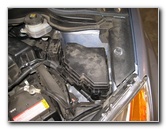 2011 CR-V Engine Bay |
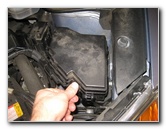 Push In Front Release Tab |
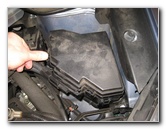 Push In 2nd Release Tab |
| This
automotive maintenance tutorial was specifically written to assist owners of the
third generation (2007, 2008, 2009, 2010 & 2011) Honda CR-V in
troubleshooting an electrical problem by checking or changing a
blown fuse or relay in either the engine bay or interior passenger
compartment fuse blocks. Owners of other Honda or Acura vehicles such as the Pilot, Insight, CR-Z, Accord, Civic, Fit, Crosstour, Odyssey, Ridgeline, TSX, ILX, TLX, TL, RLX, RDX and MDX may also find these DIY instructions to be helpful. The 3rd generation CR-V is equipped with either the standard mini blade fuses or "low profile" mini blade fuses depending on the model year. Please check your vehicle before purchasing new fuses. A white plastic fuse puller tool is included on the underside of the engine bay fuse box cover. |
||
|
|
||
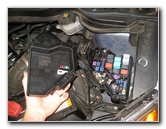 Pull Off Fuse Box Cover |
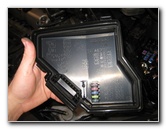 Spare Fuses & Puller Tool |
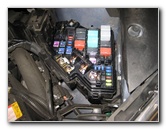 Engine Bay Fuse Panel |
| The engine bay fuse
box is located on the right (driver) side of the engine bay behind the
headlight and near the 12V automotive battery. Gently push in the two release tabs on the left (passenger) side of the fuse box to release the clips. Pull the cover straight off the top of the fuse box. There is a fuse location diagram on the underside of the fuse box cover and also another one in the owner's manual. A white plastic fuse puller tool and a few spare mini blade fuses are attached to the underside of the cover. If your CR-V is equipped with the slightly taller mini blade fuses, you should be sure to only purchase those replacement fuses. If your CR-V is equipped with the newer "low profile" mini blade fuses, you may replace them with either the same low profile fuses or the slightly taller mini blade fuses. Both types will fit in the sockets with the taller mini blade fuses just not sitting flush with the panel. I'd recommend purchasing an assortment box of replacement fuses in a variety of amperage ratings (5, 10, 15, 20, 25, etc), which are available at stores such as Pep Boys, Advance Auto Parts, Napa, AutoZone, Walmart or online at Amazon. |
||
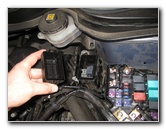 Relay Box Cover |
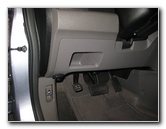 Under Driver Side Dashboard |
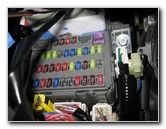 Interior Fuse Block |
| There is a small
black plastic relay box just to the left of the engine bay fuse block. The interior passenger compartment fuse panel is located below the dashboard near the driver's left knee and to the left of the parking brake lever. There is fuse location diagram for the interior electrical panel in the owner's manual. |
||
|
|
||
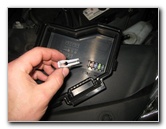 White Plastic Fuse Puller Tool |
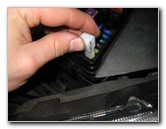 Place Jaws Over Fuse |
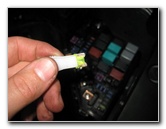 Low Profile Mini Blade Fuse |
| Place the jaws of
the fuse puller tool over the top of the fuse you'd like to check or change
and pull it straight out of the socket. This 2011 Honda CR-V is equipped with the "low profile" mini blade fuses where the metal contacts are almost flush with the bottom of the plastic fuse body. If your CR-V has the standard mini blade fuses, the electrical contacts will extend out further from the plastic case. |
||
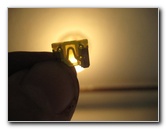 Hold Fuse Up To Light |
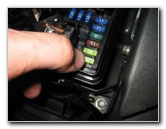 Push In New Mini Fuse |
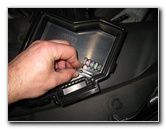 Replace Fuse Puller Tool |
| Hold the old fuse
up to a light source and inspect the thin metal strip inside the translucent
plastic center of the case. If the thin metal strip inside the translucent plastic center of the old fuse appears broken or "burnt" it is most likely "blown" and needs to be replaced. If the thin metal bar inside the old fuse appears to be intact, the fuse is most likely still good. But since new fuses are so inexpensive, the fuse should be still be replaced as part of your electrical issue troubleshooting process. Push a new mini blade fuse of the same amperage rating (e.g. 5, 10, 15, 20, 25) straight in to the socket. |
||
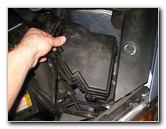 Lower Fuse Block Cover |
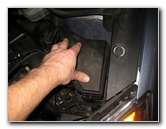 Push Cover In Place |
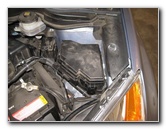 Electrical Fuse Replaced |
Push the engine bay fuse box cover back down in place. If the electrical issue still persists after changing the fuse, you may have a shorted wire somewhere or the faulty component needs to be replaced. For more,
check out my other
Honda CR-V Repair & Maintenance Guides. |
||
| If you found this guide to be helpful,
please consider making a small donation by clicking on the PayPal.com
"Donate" button located to the right of this paragraph. Thank you!
(Note: I am not a registered charity. Donations are not tax deductible.) |

